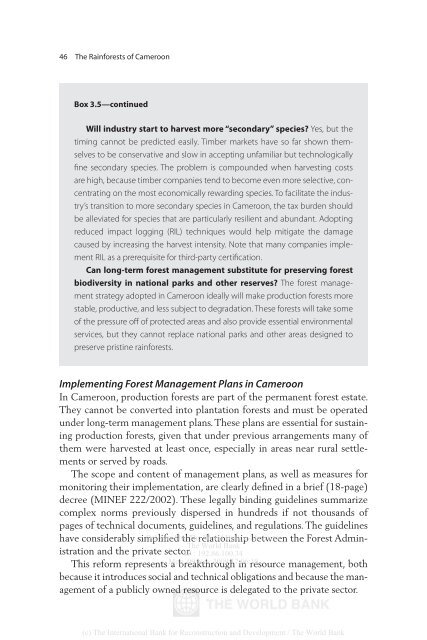The Rainforests of Cameroon - PROFOR
The Rainforests of Cameroon - PROFOR
The Rainforests of Cameroon - PROFOR
- No tags were found...
You also want an ePaper? Increase the reach of your titles
YUMPU automatically turns print PDFs into web optimized ePapers that Google loves.
46 <strong>The</strong> <strong>Rainforests</strong> <strong>of</strong> <strong>Cameroon</strong>Box 3.5—continuedWill industry start to harvest more “secondary” species? Yes, but thetiming cannot be predicted easily. Timber markets have so far shown themselvesto be conservative and slow in accepting unfamiliar but technologicallyfine secondary species. <strong>The</strong> problem is compounded when harvesting costsare high, because timber companies tend to become even more selective, concentratingon the most economically rewarding species. To facilitate the industry’stransition to more secondary species in <strong>Cameroon</strong>, the tax burden shouldbe alleviated for species that are particularly resilient and abundant. Adoptingreduced impact logging (RIL) techniques would help mitigate the damagecaused by increasing the harvest intensity. Note that many companies implementRIL as a prerequisite for third-party certification.Can long-term forest management substitute for preserving forestbiodiversity in national parks and other reserves? <strong>The</strong> forest managementstrategy adopted in <strong>Cameroon</strong> ideally will make production forests morestable, productive, and less subject to degradation. <strong>The</strong>se forests will take some<strong>of</strong> the pressure <strong>of</strong>f <strong>of</strong> protected areas and also provide essential environmentalservices, but they cannot replace national parks and other areas designed topreserve pristine rainforests.Implementing Forest Management Plans in <strong>Cameroon</strong>In <strong>Cameroon</strong>, production forests are part <strong>of</strong> the permanent forest estate.<strong>The</strong>y cannot be converted into plantation forests and must be operatedunder long-term management plans. <strong>The</strong>se plans are essential for sustainingproduction forests, given that under previous arrangements many <strong>of</strong>them were harvested at least once, especially in areas near rural settlementsor served by roads.<strong>The</strong> scope and content <strong>of</strong> management plans, as well as measures formonitoring their implementation, are clearly defined in a brief (18-page)decree (MINEF 222/2002). <strong>The</strong>se legally binding guidelines summarizecomplex norms previously dispersed in hundreds if not thousands <strong>of</strong>pages <strong>of</strong> technical documents, guidelines, and regulations. <strong>The</strong> guidelineshave considerably simplified Delivered by the <strong>The</strong> relationship World Bank e-library between to: the Forest Administrationand the private sector. IP : 192.86.100.34<strong>The</strong> World BankThis reform represents Mon, a breakthrough 09 Nov 2009 17:06:18 in resource management, bothbecause it introduces social and technical obligations and because the management<strong>of</strong> a publicly owned resource is delegated to the private sector.(c) <strong>The</strong> International Bank for Reconstruction and Development / <strong>The</strong> World Bank
















